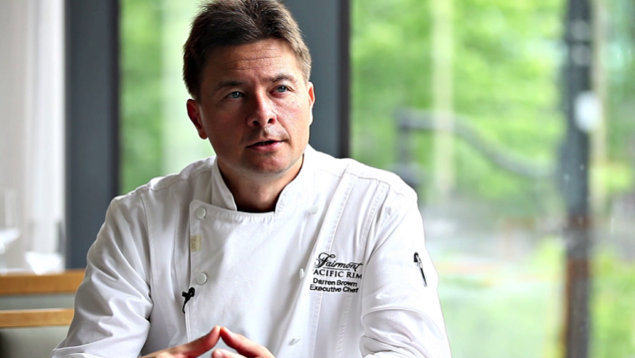
Once you’ve heard Anita Stewart describe Canada’s regional foods in loving detail, it’s hard not to beg for a place at her table! After all, she is the person who popularized the idea of Canadian cuisine. She comes by her passion for local honestly — from a childhood nourished by the regional farmland in Southern Ontario, to a lifetime spent seeking out the flavours each region and culture in Canada has to offer — she’s worked hard to bring Canadian cuisine to the world! It’s not surprising that her work was recently awarded The Order of Canada.
Anita has covered the country by dogsled, ice-breaker and old-fashioned jet to bring Canada’s regional and heritage specialties to international attention. Here, we catch her in a spare moment between writing books and winning awards to learn more about her abiding love for local.
Buy Local Eat Natural: You’ve become an acclaimed expert on Canadian cuisine. How did your passion for Canadian cuisine develop and what inspired you to enter the culinary world at the beginning of your career?
Anita Stewart: Growing up in the countryside near Toronto, food was unsophisticated and fresh. My childhood days were filled by picking raspberries and marvelling at how high the black currant bushes were. I watched the asparagus patch for the first spring shoots and ate sugar-dipped rhubarb stalks and chased the neighbour’s geese that ravaged our gardens. In the late 1950s, when my mother and I moved ‘home’ to Mount Forest, the centre of Ontario’s farming country, we used bottled dressings and packaged cheese slices, but we also tapped our own trees to make maple syrup in the spring and hunted the dusty back roads in the summer for chokecherries and elderberries to make summer jellies. In August, we filled the fruit cellar with pickles, and at Christmas we hand-dipped chocolates and feasted on roast goose.
Local food was key then but it wasn’t until much later that I found my own food voice and became truly strident in support of Canadian farmers and fishers. I was fuelled by the passion of knowing that I might just be able to help change things. At that stage of our national culinary development (in the 1980’s and early 1990’s) we still judged the quality of our cuisine by how exotic it was and how far it had travelled to reach our plates. It seemed that even the growers didn’t ‘get it.’ However, there were a cadre of food professionals who did and that’s what made the difference. Together, we instigated the Northern Bounty conferences, held across Canada in celebration of our regional foods, in Stratford, Vancouver, Guelph, Halifax, Calgary/Jasper, Winnipeg and Kelowna.
BLEN: Because Canada has many defined seasons, how does your cooking shift between summer and winter?
AS: In the spring and summer I grill a lot and make salads that are often more of an exercise in ‘naming that green’. I use a lot of edible flowers: tulips and tuberous begonias are my favourites.
In the autumn and winter, there are soups. Spicy buttermilk-laced butternut squash is a real favourite and stews, including one that is a real hit where I clay bake pork and apples together. I bake bread, including egg-rich brioche, cinnamon sticky buns and foccacia fragrant with rosemary. Root vegetables rock; Ontario’s winter carrots are so sweet. I break out the frozen corn that I’ve smoked to add to the soups for an almost meaty flavour. And I make kettles-full of pasta sauce with lots of fennel and garlic using the summer’s tomatoes.
BLEN: What do you think is the quintessential Canadian winter holiday treat?
AS: Homemade dinner rolls. In my house we call them Grandma Buns as it was my mom who used the recipe first, and it was traditional that she would bake them for whatever holiday we were having. A warm roll – split and buttered – is about as close to heaven as it gets. The problem is stopping at just one. (Editor’s note: Try them for yourself at the end of this post – she shared the recipe with us!)
BLEN: How has Canadian cuisine changed since the beginning of your career?
AS: What has really changed is our attitude. We are no longer judging the quality of our ingredients by how far they travel. We are realizing that the closer to home our food is grown, the better, and generally, the more delicious. It’s an incredible smorgasbord. We are recognizing that the ingredients and the talent we have in both home and professional kitchens all across Canada is as good as any on earth. Twenty years ago, garam masala, Thai chilis, white asparagus, purple carrots, heritage pork, heirloom tomatoes and artisan cheeses were virtually unknown. Today, the palate has broadened exponentially and our farmers have responded.
BLEN: Do you have a favourite area of Canada for food inspiration?
AS: I’m not trying to avoid the question, but no matter where I travel, there’s inspiration. All you need to pack is your curiosity. Life is good you know…and there is a lot of Canada to eat!
We asked Anita to share her favourite recipe with us and she generously provided us not only with her mom’s “Grandma Buns” (her personal quintessential Canadian dish!) as well as the Clay Baked Pork with Apples dish she mentioned…and also Latvian Bacon & Onion-stuffed Rolls (Piradzini), and Peter’s Brioche. Check out (and taste-test) more of Anita’s favourites in Anita Stewart’s CANADA: The Food, The Recipes, The Stories – a collection of local recipes and stories from across the country.
Mom’s Prize-winning Dinner Rolls
2 ½ cups lukewarm water 625 mL
¾ cup granulated sugar 175 mL
2 tbsps dry active yeast 30 mL
2 eggs, lightly beaten 2
1 ½ tsp salt 7 mL
¾ cup canola oil 175 mL
7-8 cups all-purpose flour 1.75 -2 L
In a large mixing bowl, combine ½ cup (125 mL) of the water with 2 tsp (10 mL) of the sugar, stirring to dissolve. Sprinkle yeast over and let stand for 10 minutes or until frothy.
Whisk in remaining water, sugar, eggs, salt and oil. Beat in flour, one cup (250 mL) at a time, to make a soft, sticky dough. Turn out onto a well-floured board and knead until smooth and very elastic, about 5 to 7 minutes. Place dough in a lightly greased bowl, turning dough to grease all over. Cover with greased waxed paper and a tea towel. Let rise in a warm place until doubled, about 1 ½ to 2 hours.
Punch down dough and shape into balls the size of golf balls. Place 2 inches (5 cm) apart on well-greased or parchment-lined baking sheets. Cover with a tea towel and let rise until doubled, about 1 ½ hours.
Bake in preheated 375° F (190° C) oven for 12 to 15 minutes or until golden brown and buns sound hollow when tapped on bottom.
Makes about 4 dozen rolls.
Clay Baked Pork With Apples
Anita says: Clay baking is ancient and the foods that are created by this supremely simple method rival any braised dish that a cook can serve. The only prerequisite is that the clay pot has to be soaked for a few hours. Put it into the sink immersed in cold water for the day or overnight. Once the pot is soaked, it’s faster than any method that I know – other than in a pressure cooker– and it’s the easiest way to create a perfect winter meal that I’ve ever found.
This is freeform cooking. Depending on the size of your baker you can add a few potato chunks, some celery, a few pieces of squash or a chopped, unpeeled tomato. After the baker is full of meat, vegetables and apples, add enough cider and stock so that it’s visible just below the surface. My clay baker takes about 2 to 2 ½ cups (500 – 625 mL) of liquid.
2 – 3 lbs (900 – 1350 g) lean pork
1 large onion, coarsely chopped
3 carrots, peeled and cut into 1”(2.5 cm) chunks
1 large cooking apple, cored and chopped
1 ½ cups (375 mL) apple cider
1 ½ cups (250 – 375 mL) chicken stock
1 tsp (5 mL) salt
½ tsp (2 mL) hot paprika
½ tsp (2 mL) freshly ground pepper
2 tbsps (30 mL) cornstarch
Soak the clay baker in cold water for 4 – 6 hours. Set on a towel and add the pork, onion, carrots, apple, apple cider, 1 cup (250 mL) of the chicken stock, salt, paprika and pepper. Cover and place into a cold oven. Bake at 350’F (180’C) for 3 hours. Stir the cornstarch into the remaining stock till smooth; set aside.
About 30 minutes before the baking time is up, carefully remove the baker from the oven, loosening the lid with a sharp knife if necessary. Stir in the stock/cornstarch mixture, stir, re-cover and return to the oven to thicken and finish baking.
Makes 4 to 6 servings.
Latvian Bacon & Onion-stuffed Rolls (Piradzini)
Anita says: A celebration in the scattered Latvian communities of Canada often include these bacon-filled buns. They are fabulous with a salad for a quick lunch or, if you make them smaller, are great cocktail appetizers.
This recipe was one of those that the late Tanya Barsevski shared with me years ago while she still lived in the farm town of Mount Forest and cooked at the local high school…a time when secondary schools had real kitchens.
Dough:
1 medium potato, peeled and diced
1 cup (250 mL) water
1 tsp (5 mL) salt
1 tbsp (15 mL) granulated sugar
2 tbsps (30 mL) butter
1 ½ – 2 cups (375 – 500 mL) all purpose flour
2 tsps (10 mL) instant yeast
Filling:
¼ lb (110 g) lean side bacon, finely diced
2 small onions, finely minced
1 green onion, minced
½ cup (125 mL) finely diced ham
½ tsp (2 mL) freshly ground pepper
Egg Wash:
1 egg yolk
¼ cup (60 mL) milk
In a saucepan combine the potato, water and salt. Cover and bring to a boil: reduce heat and simmer for 15 – 20 minutes or until tender. Drain, reserving liquid and mash thoroughly. Stir in sugar, butter and reserved water. Let cool till lukewarm.
Beat in 1/2 cup (125 mL) of the flour. Add yeast, beating vigorously till well combined, 1 to 2 minutes. Add enough of the remaining flour to make a stiff dough. Turn out onto a floured surface and knead, adding flour as needed to keep from sticking, until smooth and elastic, about 4 – 5 minutes. Place in a well-oiled boil, cover with a damp towel and let rise till doubled, about 1 to 1 ¼ hours.
Meanwhile, make the filling. In a heavy saucepan, cook bacon, onions, green onion, diced ham and pepper, until onion is softened and bacon begins to crisp. Let cool completely.
When the dough has doubled, punch down and divide into 16 pieces. Roll each piece to flatten slightly. Place a spoonful of the bacon mixture onto the centre of each bit of dough. With floured fingertips, pinch edges together to make crescent. Place each piradzini about 2” (5 cm) apart on a parchment-lined baking sheet. Slash tops with a sharp knife. Cover loosely with a towel; let rise until doubled, about 50 – 60 minutes.
Whisk the egg yolk and milk together. Brush over crescents. Bake in a preheated 375’F (190’C) oven for 15 to 20 minutes or until very well browned.
Makes 16.
Peter’s Brioche (these are featured on the cover of “Anita Stewart’s CANADA: The Food, The Recipes, The Stories” (http://www.anitastewart.ca/food-books))
Anita says: Elora’s Peter Skoggard is a composer, a massage therapist and at one point in his colourful career operated one of Toronto’s first completely vegetarian restaurants, The Cow Café. During that urban hiatus, people came from across the city every Sunday morning to consume his brioche. His food vocabulary is as complex and educated as his musical talent and there is no doubt that, when he bakes, he brings a bit of magic to the kitchen.
According to Peter, brioche goes against every bread-baking tenet in the book…too much butter…too many eggs. But made on a cool day and according to his instructions (and with a little prayer), it will be the best, richest and most sensuous bread you will ever make.
Yeast Sponge:
½ cup (125 mL) warm water
1 tsp (5 mL) liquid honey
2 tbsps (30 mL) active dry yeast
¾ cup (175 mL) all purpose flour
Brioche Dough:
4 cups (1 L) all purpose flour
1 tbsp (15 mL) salt
½ cup (125 mL) liquid honey
8 eggs
1 cup (250 mL) butter, softened
Additional flour, as needed (about 2 cups/500mL)
Egg Wash:
1 egg yolk, well beaten
2 tbsps (30 mL) milk
Yeast Sponge. Rinse a small bowl with hot water to warm it. Measure in the warm water, honey and yeast. Stir and set aside to puff, about 7 – 10 minutes. Sprinkle with flour, stirring with fork to make a thick batter. Let rise in a warm place for 10 minutes or until sponge-like.
Brioche Dough. Measure flour and salt into a large bowl. Make a well in the centre and pour in the honey. Add eggs and yeast sponge, mixing until sticky and well-blended. Turn onto a generously floured board and knead in additional flour until smooth.
With a fork, mash the butter roughly. Knead briefly. It should be the consistency of the dough but not melting.
On a well-floured board, flatten the dough with the heel of your hand and press (Peter says “squish”) the butter into it. Fold it up and knead a few turns, gathering and folding gently. The dough will be very sticky. Add flour if it is too sticky to work with and knead gently for 1 minute ensuring that the surface on which you are kneading it remains floured. .
Cover the dough with a kitchen towel; let rise for 1 ½ to 2 hours or until doubled. (The first rising will take longer because “The yeasts are overcoming their environmental difficulties.” ) When double, punch down and let rise again till doubled, 30 minutes to 1 hour.
Punch down and shape.
For classic Brioche, thoroughly butter or oil 2 large or 18 brioche moulds. The are deeply fluted metal tins . Divide the dough half or into into 18 pieces. To shape the large brioche, simply tear off a golf-ball sized chunk of dough of each half and roll. Shape the larger pieces into rounds and place into the tins. Make a deep indentation in the top of the dough and insert the smaller chunk firmly.
To shape each brioche, tear off a small marble sized piece of dough. Roll both into rounds. Place the larger round into the mould and poke your finger into the top making an indentation for the smaller marble-sized piece. Repeat using all the dough.
Cover and let rise till doubled.
To bake, make the egg wash by mixing the yolk and milk together. Using the lightest of pastry brushes, brush onto the unbaked brioche. Bake in a preheated 350’F (180’C) oven till richly golden. For the larger brioche remove the middle rack to allow them to rise and bake evenly till golden brown, about 40 minutes. For the smaller brioche, let the rack remain and bake them in the middle of the oven for 25 to 30 minutes.
Let cool for 15 – 20 minutes on a wire rack before removing from the pans.
Makes 2 large or 18 small brioche.


